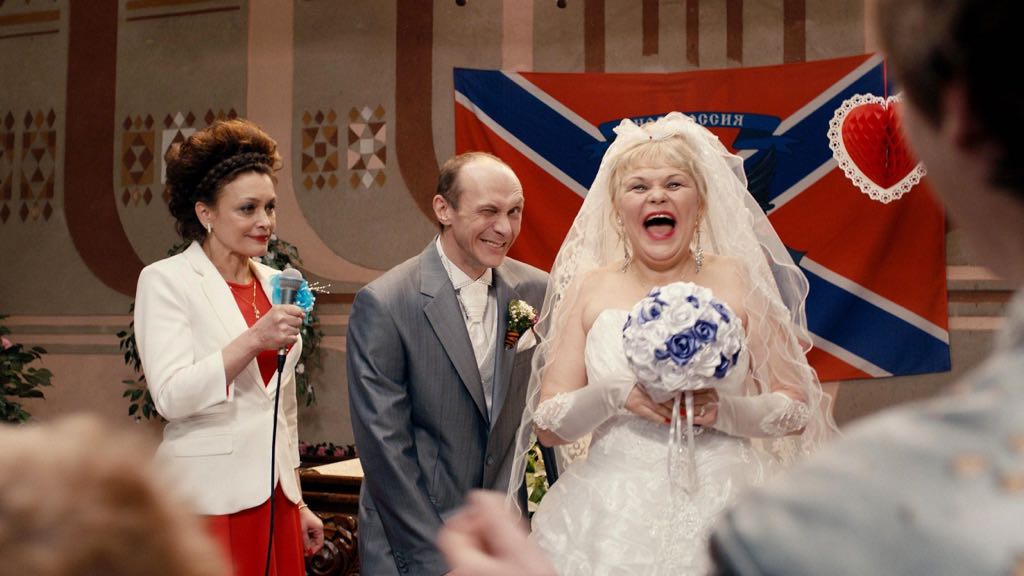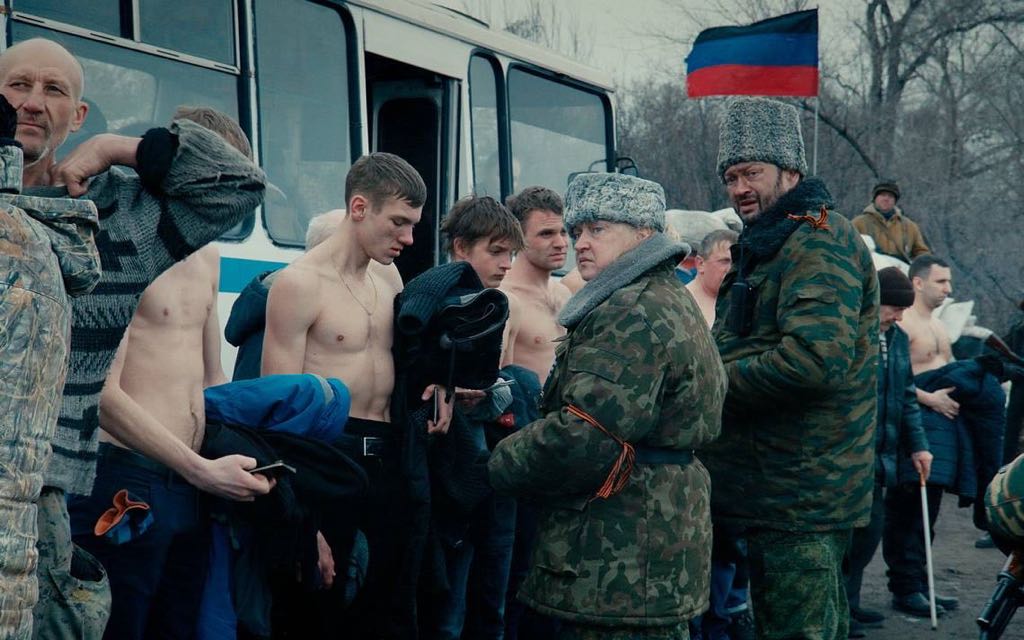Shown at the Rotterdam Film Festival and now available in select theatres in the Netherlands, Sergei Loznitsa’s latest film paints a hopeless portrait of the war in Eastern Ukraine. It uses black humour to make sense of the harsh reality.
 Wedding scene from "Donbass".
Wedding scene from "Donbass".
by Chris Colijn
Sergei Loznitsa’s latest film balances between comedy and tragedy. This is the director’s third film of 2018, after The Trial and Victory Day, both documentaries. Donbass is a feature film based on various videos shared to YouTube over the past years by eyewitnesses to the ongoing war in Eastern Ukraine.
Loznitsa reconstructed amateur videos in a dramatized form. In terms of style, the film retains some of the amateur quality of the original recordings. In thirteen stories, he provides an insight into life in the so-called Donetsk and Luhansk People’s Republics, also referred to in the film as Novorossiya (New Russia).
The director was born in Belarus, but moved to Kyiv, Ukraine at a young age and has a Ukrainian passport. He is known for documentaries about the failed Soviet coup of August 1991 and the Euromaidan Revolution. Loznitsa has lived in Germany since 2001, and has made films about each of the four countries in which he lived. His films often focus on wars, revolutions, and history.
Brutal violence and luxury
Donbass’s episodes are for the most part not directly linked to each other, but show the war from different viewpoints. Some show the brutal violence, shameless thievery, and power politics of those at the head of the so-called ‘people’s republics’. Traitors are punished and innocent civilians are forced to live in mouldy bunkers while the authorities abuse their power to live in luxury and extort their subjects. Other stories remind viewers that despite the utter hopelessness and chaos, life goes on. Couples still get married and ordinary civilians try to thrive under the new rules. However, a sense of despair pervades the film as ordinary civilians struggle to survive.
The film’s subject matter makes it inherently political. Donbass was sponsored by the Ukrainian Ministry of Culture as well as several European film funds. The film labels the so-called People’s Republics as “occupied territory," and makes it clear that these states, run mainly by criminals and lesser oligarchs of the previous leadership, could not exist without far-reaching Russian support.
Despite its staunchly pro-Ukrainian standpoint, the film is nuanced: there are clear references to the frustrations of the local inhabitants of Donbas towards the Ukrainian authorities for their corruption and the country’s economic hardship.
Donbas’ new leadership is certainly no better, with bandits now in charge. Loznitsa has focused on outcasts before, for example in his films My Joy (2010) and The Fog (2012). In Donbass, they take revenge and become the leaders of their own republic.
As could be expected, the film was criticized. In Russian government circles (for example, see the Facebook post of the Russian embassy in Australia) it is classified as “Russophobic propaganda” with a “fascist morality”. The film also received criticism in Ukraine, with some saying that it portrays the potential of the Donbas region in an unfairly negative light and does not tell the whole story.
Quasi-documentary
Using a sober colour palette and mostly leaving music out of the film, Loznitsa presents life in Donbas in a raw and chaotic light. Its cinematography mimicks the use of mobile phones as recording devices, thereby strengthening the film’s quasi-documentary character and reminding viewers of the YouTube videos on which the stories are based.
Many scenarios are bizarre and it often seems like the inhabitants of Donbas are performing roles which they are still getting used to. Bandits become soldiers and politicians, while professional actors are hired to act as local civilians and inform television news channels of the latest atrocities committed by the ‘fascists’. A captive cook who served on the Ukrainian side of the war is tied to a lamppost with a sign taped to him reading “participant in extermination squad”. He takes on the role of a brutal killer while bystanders (innocent civilians) heckle and eventually lynch him.
With his method of filmmaking, Loznitsa was able to show violence without overdoing it. “I have to think about by viewers,” he said after a screening in Amsterdam. He manages to convey the dark, grotesque humour of the situation, in which one scene is almost funny while the next shows the horrible reality of war. “You don’t know whether to laugh or to cry, but this is real life.”
 Scene from the film "Donbass". Upon entering the region, men are forced to undressed and interrogated.
Scene from the film "Donbass". Upon entering the region, men are forced to undressed and interrogated.
Persistent conflict
The ongoing almost-frozen war in Eastern Ukraine means is rarely reported on, and has slipped off of the agendas of political leaders. Meanwhile, 13,000 people have died since 2014 and the Minsk II agreements are being violated on a daily basis.
Loznitsa’s view on the roots of the conflict appear in the film and in discussion with him. He says that after the fall of the Soviet Union, there was no proper plan for the future of Donbas, where heavy industry and coalmines once brought prosperity. However, this industry has been heavily subsidised since the 1980s. Instead of progress, there is a revival of nostalgia to Soviet times, which many inhabitants of the separatist republics (of whom approximately 40% are ethnically Russian) see as a better time. This sentiment is presented along with hostility towards Ukraine’s political leadership and the influence of Russian disinformation as the conflict’s breeding ground.
Donbass is not a film about geopolitics. Instead, it focuses on the lives of normal people, so that the state of war and its absurd effects on daily life become relatable to non-Ukrainians.
Donbass, the latest film by Ukrainian-Belarusian director Sergei Loznitsa, received widespread acclaim and won the Un Certain Regard Directing Prize at the 2018 Cannes Film Festival. It was shown at the 2019 International Film Festival Rotterdam, where the director was present at some screenings to answer questions and give insights into the film’s production. From February 7th onward, the film will be shown at selected theatres in the Netherlands. Click here for more information on these screenings.
